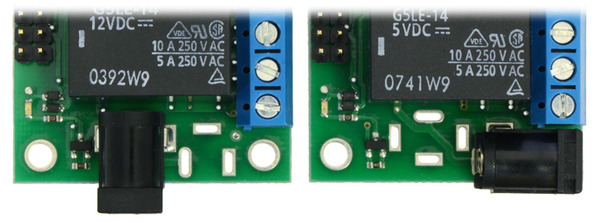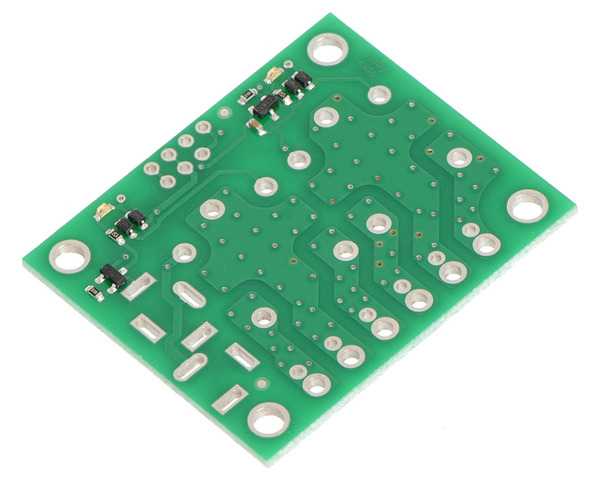Electronics Prototyping » Switches, Buttons, and Relays » Relay Modules »
Pololu Basic 2-Channel SPDT Relay Carrier for "Sugar Cube" Relays
This basic 2-channel relay carrier board makes it easy to incorporate two single-pole, double-throw (SPDT) “sugar cube”-style power relays into your electronics project. Integrated MOSFETs allows the relays to be controlled with low-current digital inputs, and indicator LEDs show when the relays are activated. The control pins have a 0.1″ spacing compatible with standard solderless breadboards and servo cables, and the switch pins are available for use with 5mm-pitch terminal blocks or 0.2″-spaced pins. Note: Relays not included.
Alternatives available with variations in these parameter(s): channels voltage style Select variant…
| Description | Specs (8) | Pictures (9) | Resources (6) | FAQs (0) | On the blog (0) | Distributors (23) |
|---|
Overview
The Pololu basic relay carrier modules make it easy to control electrically isolated, single-pole, double-throw (SPDT) switches from low-voltage, low-current control signals. The modules are available in single-channel and dual-channel versions with 5 V or 12 V power relays—Omron G5LE-14-DC5 and G5LE-14-DC12 (1MB pdf), respectively—and with a variety of connector and assembly options.
The following table lists the available Pololu basic SPDT relay carrier options:
| Channels | Board size | Mounting holes |
DC power jack option |
Relay coil voltage |
Coil resistance |
Active current at rated voltage |
Connector and assembly options | Item # | Price | |
|---|---|---|---|---|---|---|---|---|---|---|
 Single-relay |
1 | 1.15″ × 1.0″ | 4× 0.086″ (#2 or M2) |
no | 5 V | 63 Ω | 80 mA | • with JST SH-style connector, assembled | 5662 | $7.95 |
| • with 0.1″ headers, assembled | 2480 | $7.95 | ||||||||
| • with 0.1″ headers, partial kit | 2481 | $6.95 | ||||||||
| 12 V | 360 Ω | 34 mA | • with JST SH-style connector, assembled | 5663 | $7.95 | |||||
| • with 0.1″ headers, assembled | 2482 | $7.95 | ||||||||
| • with 0.1″ headers, partial kit | 2483 | $6.95 | ||||||||
| N/A | N/A | N/A | • carrier board with JST SH-style connector only (no relay) | 5664 | $3.95 | |||||
| • carrier board only (no relay or connectors) | 2479 | $3.95 | ||||||||
 Dual-relay |
2 | 1.5″ × 1.8″ | 4× 0.125″ (#4 or M3) |
yes | 5 V | 63 Ω | 80 mA | • with JST SH-style connector, assembled | 5665 | $14.95 |
| • with 0.1″ headers, assembled | 2485 | $14.95 | ||||||||
| • with 0.1″ headers, partial kit | 2486 | $13.49 | ||||||||
| 12 V | 360 Ω | 34 mA | • with JST SH-style connector, assembled | 5666 | $14.95 | |||||
| • with 0.1″ headers, assembled | 2487 | $14.95 | ||||||||
| • with 0.1″ headers, partial kit | 2488 | $13.49 | ||||||||
| N/A | N/A | N/A | • carrier board with JST SH-style connector only (no relays) | 5667 | $7.49 | |||||
| • carrier board only (no relays or connectors) | 2484 | $6.95 | ||||||||
Alternatives available with variations in these parameter(s): channels voltage style Select variant…
Details for item #2484
This carrier version is just the PCB assembled with all of its surface mount components, including MOSFETs for controlling the relays, indicator LEDs, and a flyback diode.
Note: This product does not include relays or connectors for the switch pins. The board works with single-pole, double-throw (SPDT) power relays that have the common “sugar cube” pinout and footprint. Versions with relays included are also available (see the selection table near the top of this page).
Advantages over similar products
- Compact layout
- Two LEDs to indicate coil actuation
- Zener diode for fast current decay on relay coil
- Specification of electrical routing clearance/creepage rules on relay switch nodes
Using the relay module
 |
The switch portions of the relays (NCx, COMx, and NOx) are accessible on one side of the board via larger holes that work with 5mm-pitch terminal blocks or smaller holes that work with 0.2″ headers. The control pins (GND, VDD, EN1, and EN2) are routed to the 0.1″-pitch through-holes on the other side of the board that work with 0.1″ straight or 0.1″ right-angle headers. The relay coils are powered by supplying the relay’s rated coil voltage across the VDD and GND pins, and they are activated by digital high (2.5 V to 20 V) control signals on the respective EN pins. The control signals are fed directly to BSS138K N-channel MOSFETs, which in turn actuate the relay coils when the control voltages exceed approximately 2.5 V, up to a maximum of 20 V (see BSS138K datasheet (517k pdf) for details). Each relay has a corresponding red LED that lights up when the relay coil is active. The carrier board has four mounting holes that work with #4 or M3 screws.
The relay switch terminals COM (common), NO (normally open), and NC (normally closed) are routed on the PCB with a minimum clearance/creepage of 60 mil (1.5 mm) from other copper. The copper traces are designed to be at least 45 mil (1.1 mm) from the board edges, though manufacturing variations in the board edges can make those distances slightly lower.
In most applications, the current and voltage ratings for the module will match the ratings of the relay used. Maximum current, maximum voltage, and life expectancy are interdependent; we therefore recommend careful examination of your relay’s datasheet.
Warning: This product is not designed to or certified for any particular high-voltage safety standard. Working with voltages above 30 V can be extremely dangerous and should only be attempted by qualified individuals with appropriate equipment and protective gear.
Optional DC barrel jack
 |
The carrier board makes it possible to optionally power the relays from a DC barrel jack (not included). The DC barrel jack can be placed in three configurations, two of which are shown in the pictures above (the jack can also be installed in one configuration on the bottom side of the PCB).
Schematic diagram
 |
Schematic diagram of the Pololu basic 2-channel SPDT relay carrier with 0.1″ headers. |
|---|
This schematic is also available as a downloadable pdf (128k pdf).



























